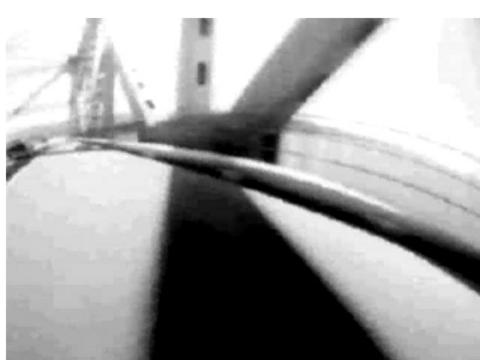[caption id="" align="alignnone" width="960" caption="The Black Lung Theatre 2011, Sean Young"]
 [/caption]
[/caption]The five members of The Black Lung Theatre and Whaling Firm that have spent the last months developing I Feel Awful have some pretty strong feelings about theatre and theatre's communicative functions, and they want these feelings to be witnessed. In the Bille Brown studio, director and writer Thomas M Wright has found a forum to air his grievances about an industry he finds lacking (an industry that Gow, the QTC and ultimately The Black Lung themselves are ultimately immersed in). Soon after the coldest of cold opens, the young performers from Brisbane acting schools that join the production (called at times "the teens") demonstrate a gamut of rapid-fire dramatic skills, pre-empting the rollerskate tour of genres and intentions of theatre that Wright turns his critical eye to.
The 1992 film Stay Tuned, directed by Peter Hyams, featured the lazy Roy and under-appreciated Helen who are trapped by an undercover envoy from Hell. Their prison is an alternate "TV" reality - across the 90 or so minutes of the movie's duration the pair have to negotiate darkly satirical representations of popular shows (Fresh Prince of Darkness, Autopsies of the Rich and Famous). The overarching message is TV is dangerous - the Devil himself wants to welcome 'TV Junkies' into his fold in the most gruesome way possible.
[caption id="" align="alignnone" width="580" caption="Stay Tuned (1992)"]
 [/caption]
[/caption]Reflecting on Stay Tuned it now seems foolhardy to stage a critique of screen-based media on the screen - luckily I Feel Awful is more than just disgruntled. However cheesy, where Stay Tuned has the jump on Wright is the the ease at which scenes can transition - at the point of critical action, or more likely when the already laboured gags have stretched themselves too thin, someone clicks a remote and the scenery change. Changing scenes in front of a live audience is obviously a more physical affair, and it's an effort the audience are forced to observe more than once.
The second challenge of live-action theatre as multimodal as Wright has developed is establishing an evenness of the component elements. I Feel Awful at times appears shaky but never topples, although at times this writer questioned the necessity of the application of dance.
Costuming is of obvious importance to I Feel Awful. Clothing is judged, employed at the level of metaphor, soiled and discarded. By this writer's count at least five outfits appear for each of the fourteen performers on stage. The Black Lung wear variations on a a traditional staid business theme. This seems to be a trope all of its own: the professional thieves in Reservoir Dogs, Joaquin Phoenix in his efforts to establish himself as a hip hop artist, the live performances of Nick Cave - far from the office, the business suit seems to be the outfit of choice for violent, desperate work.
At times the Whalers appear outside of business suits: two such moments feature Gareth Davies in a WWE dressing gown and Liam Barton wearing a Wu-Tang jersey. In contrast to the timeless business suits these items are anachronistic - the dressing gown is obviously sized for a child, and due to a market flooded with bootleg copies and Sacha Baron Cohen's Ali G, Wu Wear has substantially fallen out of popular favour. Anachronisms aside, combining World Wrestling Entertainment, Inc. with The Clan in Da Front results in a very effective analogy for The Black Lung - rambunctious, charismatic, physical and very, very male.
If this analogy rings true, it is in no small part due to Thomas M Wright, director of The Black Lung, who is very much a hybrid of Vince McMahon and RZA - confident, calculating and perpetually promoting as he performs. From start to finish, Aaron Orzech's performance makes the most hay out of the business of theatre - it's often him with the bullhorn, the clipboard or the academic reference. While those around him careen out of control, he remains the most engaging on stage for this writer by staying true to small action. It is almost impossible to assess the performances of the younger cast - if they appear over-earnest, is it by design? - but it has to be said that Finn Gilfedder is a comic standout and Charlie Schache imprints himself on the production powerfully. Overall the supporting cast acquit themselves well under complex circumstances - if they seem to lack cohesion this writer would be inclined to think that the script has left very little room for it - this is a group that has had to be divided to be conquered.
[caption id="" align="alignnone" width="650" caption="Gareth Davies in I Feel Awful"]
 [/caption]
[/caption]While exceedingly engaging, there is a lingering concern for this writer - with so much focus on gender and sexual politics, it's hard to reconcile the fact that the narrative, which concerns itself with the ways the young women can be compromised on and off the stage, has been written, developed and presented by a group of men. Having Queensland's experience of theatre critiqued by a troupe from Melboure is also a bitter pill. Speaking to Marie-Christine Sourris at the Courier Mail[ref]http://www.couriermail.com.au/ipad/play-it-once-more-with-feeling/story-fn6ck8la-1226123457398[/ref] Wright has indicated a move toward more personal content, and this writer anticipates this as a strong direction.
I Feel Awful lives up to expectations: Sex and Death are foregrounded as promised, but in an abstract, synthesised form. While the 'burn-down-the-academy' attitude to creative production isn't entirely for everybody, what The Black Lung have created for QTC is genuinely surprising, very funny and intellectually astute.
I Feel Awful: Bille Brown Studio, South Brisbane. September 2-10.
http://www.facebook.com/event.php?eid=120662311361989


